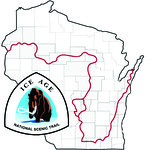 Hummock is a general geological term referring to a small knoll or mound above ground. They tend to appear in a group. Hummocks in this area are produced through a process called topographic reversal. An accumulation of supraglacial debris on the glacier surface results in hummocky topography after the glacial ice melts out. The thickness of supraglacial sediment determines the relief in the present landscape. The figure to the right shows how high points on the debris-covered ice often become low points in the landscape.
Hummock is a general geological term referring to a small knoll or mound above ground. They tend to appear in a group. Hummocks in this area are produced through a process called topographic reversal. An accumulation of supraglacial debris on the glacier surface results in hummocky topography after the glacial ice melts out. The thickness of supraglacial sediment determines the relief in the present landscape. The figure to the right shows how high points on the debris-covered ice often become low points in the landscape.
Frost-riving and other periglacial phenomena increased sediment production when ice began to form. Streams were required to carry greater loads and began to spread out and often become braided outwash areas. Both sediment load and runoff were at their greatest level during glacial maximums. Glacial minima deposited finer grained sands upon coarser gravel terraces.
When the ice finally melts away completely, areas that were high on top of the glacier become low areas that you see today. The areas that were low on top of the glacier become high areas that you see today.
Graphic is from GEOLOGY OF THE ICE AGE NATIONAL SCENIC TRAIL.by Mickelson, David M
©2011 by the Board of Regents of the University of Wisconsin System, Reprinted by permission of the University of Wisconsin Press.
 IATCC is the cache designation to highlight a series of EarthCaches along the Ice Age National Scenic Trail grouped into a special category called "ColdCache."
IATCC is the cache designation to highlight a series of EarthCaches along the Ice Age National Scenic Trail grouped into a special category called "ColdCache."
The Ice Age Trail is one of eleven National Scenic Trails designated by the National Park Service. This unique trail is entirely within the state of Wisconsin and follows along the terminal moraine of the most recent glacier which retreated about 10,000 years ago.
This project is supported by the Ice Age Trail Alliance (IATA). The goal is to bring more visitors to the trail and promote public awareness, appreciation, and understanding of Wisconsin’s glacial landscape.
The IATA has created an awards program to encourage visits to the trail and ColdCache sites. This awards program is separate from, and in addition to, any other Geo- or EarthCache awards program.
A current list of approved ColdCache sites can be found on the “IATCC Bookmark List”. More information on the Ice Age Trail Atlas, the Companion Guide, the ColdCache Project and Awards Program can be found on the “ColdCache Webpage”
DNR Permission
The Geocache Notification Form has been submitted to Mike Repyak of the Wisconsin DNR. Geocaches placed on Wisconsin Department of Natural Resource managed lands require permission by means of a notification form. Please print out a paper copy of the notification form, fill in all required information, then submit it to the land manager. The DNR Notification form and land manager information can be obtained at: www.wi-geocaching.com/hiding
Resources
Geology of the Ice Age National Scenic Trail; by David M. Mickelson, Louis J. Mahler Jr., and Susan L. Simpson
To claim this find:
Estimate the height of the high areas and depth of the low areas.
How much of a difference is there?
What does this tell you about the surface of the glacier at this location?